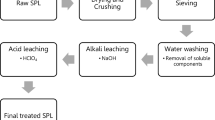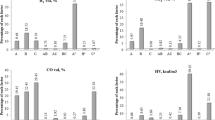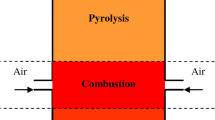Abstract
Municipal solid waste (MSW) is one of the most important carbonaceous solid waste collected by the municipality that includes residential, industrial, institutional, commercial and construction waste. In this work, modelling and simulation analyses using ASPEN plus simulation software integrated with response surface methodology (RSM)-based optimization method are used to investigate the performance of MSW gasification process. The principal objective is to develop new correlations for the key performance indicators of MSW gasification (hydrogen H2 and carbon monoxide CO contents in the syngas, cold gasification efficiency CGE, and carbon conversion CC) versus three main input factors (gasification temperature 600–1000 \(^\circ{\rm C}\), equivalence ratio 0.1–0.5, and oxygen content in air 21–100%). The MSW gasification model was developed using Aspen Plus and the results were validated with experimental data. The comparison showed a good agreement between the simulation and experimental results. RSM based on central composite design (CCD) and analysis of variance (ANOVA) were used to optimize the MSW gasification process. New correlations for the output variable (H2, CO, CGE, and CC) of the gasification process were presented by second-order polynomial equations. The results showed that the coefficients of determination \({R}^{2}\) for the predicted model for H2, CO, CGE, and CC were respectively 0.9913, 0.9630, 0.9618 and 0.9730 (high accuracy of the new proposed correlations or the regression models). The optimized gasifier operating parameters to maximize the H2, CO, CGE, and CC are T = 1000 \(^\circ{\rm C}\), ER = 0.132 and oxygen = 100%. The optimum values for the H2, CO, CGE, and CC are 44.86%, 53.8%, 95.04%, and 79.96%, respectively. The results showed that the most significant factors affecting the H2, CO, CGE, and CC in order of importance are respectively gasification temperature, oxygen percentage and equivalence ratio.









Similar content being viewed by others
Data availability
Not applicable.
Abbreviations
- \(\mathrm{Adj}-{\mathrm{R}}^{2}\) :
-
Adjusted regression coefficient
- \({\left(\frac{\mathrm{Air}}{\mathrm{Fuel}}\right)}_{\mathrm{Actual}}\) :
-
Actual air to fuel mass ratio, kg/kg
- \({\left(\frac{\mathrm{Air}}{\mathrm{Fuel}}\right)}_{\mathrm{Stoic}}\) :
-
Stoichiometric air to fuel mass ratio, kg/kg
- f:
-
Response surface
- \(\mathrm{HHV}\) :
-
Higher heating value, MJ/kg
- LHV:
-
Lower heating value, MJ/kg
- \({\mathrm{C}}_{\mathrm{Syngas}}\) :
-
Carbon in the syngas
- \({\mathrm{C}}_{\mathrm{feed}}\) :
-
Carbon in the feed
- \({\dot{\mathrm{m}}}_{\mathrm{MSW}},{\dot{\mathrm{m}}}_{\mathrm{feed}}\) :
-
Mass flow of MSW, kg/h
- \({\dot{\mathrm{m}}}_{\mathrm{syngas}}\) :
-
Mass flow of syngas, kg/h
- \(N\) :
-
Number of runs
- \(n\) :
-
Number of independent variables
- \({n}_{c}\) :
-
Number of central points with replicates or repeated runs at the centre
- \({\mathrm{P}}_{\mathrm{in}}\) :
-
Power input to the gasifier, kW
- \({\mathrm{P}}_{\mathrm{out}}\) :
-
Power output from the gasifier, kW
- \({\mathrm{R}}^{2}\) :
-
Regression coefficient
- SD:
-
Standard deviation
- \({\mathrm{x}}_{\mathrm{n}}\) :
-
Set of independent variables (factors)
- \({\mathrm{X}}_{\mathrm{i }},{\mathrm{X}}_{\mathrm{j}}\) :
-
Coded values of the input variables
- \({y}_{i}\) :
-
Mass fraction of species i in the product gas
- \({y}_{C}\) :
-
Mass percentage of carbon in ultimate analysis of original feed, %
- Y:
-
Response variable of the system
- \(\alpha\) :
-
Axial distance
- \({\upbeta }_{\mathrm{o}}\),\({\upbeta }_{\mathrm{i}}\) \({\upbeta }_{\mathrm{ii}}\) :
-
Constant, linear and quadratic coefficients
- \({\upbeta }_{\mathrm{ij}}\) :
-
Interaction between the coefficients
- \(\upeta\) :
-
Overall efficiency, %
- \(\upvarepsilon\) :
-
Random error
- ER:
-
Equivalence ratio
- CC:
-
Carbon conversion efficiency, %
- CCD:
-
Central composite rotatable design
- CGE:
-
Cold gas efficiency, %
- MSW:
-
Municipal solid waste
- RSM:
-
Response surface methodology
- ER:
-
Equivalence ratio
- CC:
-
Carbon conversion efficiency, %
- CCD:
-
Central composite rotatable design
- CGE:
-
Cold gas efficiency, %
- MSW:
-
Municipal solid waste
- RSM:
-
Response surface methodology
[1] References
Abas N, Kalair A, Khan N (2015) Review of fossil fuels and future energy technologies. Futures 69:31–49. https://doi.org/10.1016/j.futures.2015.03.003
Adeyemi I, Janajreh I (2015) Modeling of the entrained fl ow gasi fi cation : kinetics-based ASPEN Plus model. 82:77–84. https://doi.org/10.1016/j.renene.2014.10.073
Ahmad MI, Alauddin ZAZ, Soid SNM, Mohamed M, Rizman ZI, Rasat MSM, Razab MKAA, Amini MHM (2015) Performance and carbon efficiency analysis of biomass via stratified gasifier. ARPN J Eng Appl Sci 10(20):9533–9537
Ali Bahari and Kazem Atashkari JM (2020) multi-objective optimization of a municipal solid Mwaste gasifier. Biomass Convers Bioref
Fermoso J, Gil MV, Arias B, Plaza MG, Pevida C, Pis JJ, Rubiera F (2010) Application of response surface methodology to assess the combined effect of operating variables on high-pressure coal gasification for H2-rich gas production. Int J Hydrocarb Eng 35(3):1191–1204
Atnaw SM, Sulaiman SA, Suzana Y (2011) A simulation study of downdraft gasification of oil-palm fronds using. November. https://doi.org/10.3923/jas.2011.1913.1920
Authority FCS (2017). Federal Competitiveness and Statistics Authority. https://fcsa.gov.ae/en-us. Accessed 2017
Begum S (2014) An experimental and numerical investigation of fluidized bed gasification of solid waste. 43–61. https://doi.org/10.3390/en7010043
Behera SK, Meena H, Chakraborty S, Meikap BC (2018) Application of response surface methodology (RSM) for optimization of leaching parameters for ash reduction from low-grade coal. Int J Min Sci Technol 28(4):621–629. https://doi.org/10.1016/j.ijmst.2018.04.014
Bhoi PR, Huhnke RL, Kumar A, Indrawan N, Thapa S (2018) Co-gasification of municipal solid waste and biomass in a commercial scale downdraft gasifier. Energy 163:513–518. https://doi.org/10.1016/j.energy.2018.08.151
Capareda S (2013) Introduction to biomass energy conversions (1st Edition. CRS press
Chen H, Jiang W, Yang Y, Yang Y, Man X (2015) Global trends of municipal solid waste research from 1997 to 2014 using bibliometric analysis. J Air Waste Manag Assoc 65(10):1161–1170. https://doi.org/10.1080/10962247.2015.1083913
Couto N, Silva V, Monteiro E, Rouboa A (2017) Exergy analysis of Portuguese municipal solid waste treatment via steam gasification. Energy Convers Manag 134:235–246. https://doi.org/10.1016/j.enconman.2016.12.040
Douglas C, Montgomery GCR (2002) Applied Statistics and Probability for Engineers (Jhon wiley & sons (Ed.); 3rd editio)
Gagliano A, Nocera F, Bruno M, Cardillo G (2017) Development of an equilibrium-based model of gasification of biomass by Aspen Plus. Energy Procedia 111:1010–1019. https://doi.org/10.1016/j.egypro.2017.03.264
Halvorsen MSERKTBM (2015) Aspen plus simulation of biomass gasification with known reaction kinetic. 149–156. https://doi.org/10.3384/ecp15119149
Höök M, Tang X (2013) Depletion of fossil fuels and anthropogenic climate change—a review. Energy Policy 52:797–809. https://doi.org/10.1016/j.enpol.2012.10.046
Janajreh I, Raza SS (2015) Numerical simulation of waste tyres gasification. Waste Manage Res 33(5):460–468. https://doi.org/10.1177/0734242X15573656
João Cardoso VSDE (2019) Process optimization and robustness analysis of municipal solid waste gasification using air‐carbon dioxide mixtures as gasifying agent. Int J Energy Res
Kumar GS (2017) Sensitivity analysis and optimization of parameters for the gasification of high ash Indian coal. 12(18):7184–7193
Kumar S, Singh B (2018) Prediction of tool chatter in turning using RSM and ANN. Mater Today: Proc 5(11):23806–23815. https://doi.org/10.1016/j.matpr.2018.10.172
Lan W, Chen G, Zhu X, Wang X, Liu C, Xu B (2018) Science of the Total environment biomass gasification-gas turbine combustion for power generation system model based on ASPEN PLUS. Sci Total Environ 628–629:1278–1286. https://doi.org/10.1016/j.scitotenv.2018.02.159
Liu H, Hu J, Wang H, Wang C, Li J (2012) Experimental studies of biomass gasification with air. J Nat Gas Chem 21(4):374–380. https://doi.org/10.1016/S1003-9953(11)60379-4
Liu J, Wang J (2018) A multi-parameter optimization model for the evaluation of shale gas recovery enhancement.https://doi.org/10.3390/en11030654
Mäkelä M (2017) Experimental design and response surface methodology in energy applications: a tutorial review. Energy Convers Manage 151(August):630–640. https://doi.org/10.1016/j.enconman.2017.09.021
Mazzoni L, Ahmed R, Janajreh I (2017) Plasma gasification of two waste streams : municipal solid waste and hazardous waste from the oil and gas industry. Energy Proc 105:4159–4166. https://doi.org/10.1016/j.egypro.2017.03.882
Mazzoni L, Almazrouei M, Ghenai C, Janajreh I (2017) ScienceDirect ScienceDirect ScienceDirect A comparison of energy recovery from MSW through plasma The 15th International Symposium on District Heating and Cooling gasification and entrained flow gasification Assessing the feasibility the heat temperature. Energy Proc 142:3480–3485. https://doi.org/10.1016/j.egypro.2017.12.233
Mohamed AO, Sulaiman SA, Moni MNZ, Balamohan S, Atnaw SM (2016) Feasibility study of gasification of oil palm fronds. J Mech Eng Sci 9:1744–1757. https://doi.org/10.15282/jmes.9.2015.20.0168
Montgomery DC (2012) Design and analysis of experiments eighth edition. In Design (Vol. 2). https://doi.org/10.1198/tech.2006.s372
Morero B, Groppelli ES, Campanella EA (2017) Evaluation of biogas upgrading technologies using a response surface methodology for process simulation. J Clean Prod 141(September 2016):978–988. https://doi.org/10.1016/j.jclepro.2016.09.167
Plus A, Properties A, Suite AE, Technology A, Park TC, Systems O, Technology A, Park TC (n.d.) Part Number : Aspen Physical Property System 11 . 1 September 2001
Qader BS, Supeni EE, Ariffin MKA, Talib ARA (2019) RSM approach for modeling and optimization of designing parameters for inclined fins of solar air heater. Renew Energy 136:48–68. https://doi.org/10.1016/j.renene.2018.12.099
Ramarao M (2016) Evaluation of carbon conversion efficiency of mixed biomass gasification. 7(6), 555–564
Rasul MG (2014) ScienceDirect A numerical investigation of municipal solid waste gasification using aspen plus. 90:710–717. https://doi.org/10.1016/j.proeng.2014.11.800
Rejeb O, Shittu S, Ghenai C, Li G, Zhao X, Bettayeb M (2020) Optimization and performance analysis of a solar concentrated photovoltaic-thermoelectric (CPV-TE) hybrid system. Renew Energy 152:1342–1353. https://doi.org/10.1016/j.renene.2020.02.007
Sourabh J (2018) An operational analysis and congestion estimationof urban bus route based on ITS. Civil Eng Res J 3(2). https://doi.org/10.19080/cerj.2018.03.555610
StatEase (2020) StatEase. Design Expert V11. https://www.statease.com/docs/v11/contents/analysis/anova-output/. Accessed 2020
Suwatthikul A, Limprachaya S, Kittisupakorn P, Mujtaba IM (2017) Simulation of steam gasification in a fluidized bed reactor with energy self-sufficient condition. Energies 10(3):1–15. https://doi.org/10.3390/en10030314
Thakare S, Nandi S (2016) Study on potential of gasification technology for municipal solid waste ( MSW ) in Pune City. Energy Proc 90(December 2015), 509–517. https://doi.org/10.1016/j.egypro.2016.11.218
Timmer KJ (2008) Carbon conversion during bubbling fluidized bed gasification of biomass. Retrospective Theses and Dissertations, 15822. http://digitalcollections.dordt.edu/cgi/viewcontent.cgi?article=1075&context=faculty_work. Accessed 2008
Wilson DC, Velis CA (2015) Waste management — still a global challenge in the 21st century: an evidence-based call for action. Waste Manage Res 33(12):1049–1051. https://doi.org/10.1177/0734242X15616055
Xu P, Jin Y, Cheng Y (2017) Thermodynamic analysis of the gasification of municipal solid waste. Engineering 3(3):416–422. https://doi.org/10.1016/J.ENG.2017.03.004
Yu W, Sepehrnoori K (2014) An efficient reservoir-simulation approach to design and optimize unconventional gas production. March, 19–25
Yusup S, Khan Z, Ahmad MM, Rashidi NA (2014) Optimization of hydrogen production in in-situ catalytic adsorption (ICA) steam gasification based on response surface methodology. Biomass Bioenerg 60:98–107. https://doi.org/10.1016/j.biombioe.2013.11.007
Funding
The authors gratefully acknowledge the financial support by the University of Sharjah and the Research Institute for Sciences and Engineering (RISE) – Targeted Research Project (Plasma Gasification Project Ref Number 1702040686).
Author information
Authors and Affiliations
Contributions
Amira Nemmour: software, formal analysis, methodology, validation, writing – review & editing.
Abrar Inayat: methodology, validation, writing – review & editing.
Isam Janajreh: investigation, validation, writing – review & editing.
Chaouki Ghenai: conceptualization, formal analysis, investigation, methodology, supervision, project administration, validation, writing – review & editing, and securing funding.
Corresponding author
Ethics declarations
Conflict of interest
The authors declare no competing interests.
Additional information
Publisher's note
Springer Nature remains neutral with regard to jurisdictional claims in published maps and institutional affiliations.
Rights and permissions
About this article
Cite this article
Nemmour, A., Inayat, A., Janajreh, I. et al. New performance correlations of municipal solid waste gasification for sustainable syngas fuel production. Biomass Conv. Bioref. 12, 4271–4289 (2022). https://doi.org/10.1007/s13399-021-02237-8
Received:
Revised:
Accepted:
Published:
Issue Date:
DOI: https://doi.org/10.1007/s13399-021-02237-8




